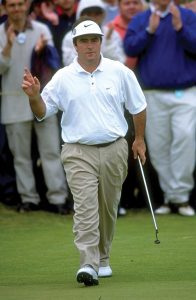THROUGHOUT his lengthy tenure as the world’s No.1-ranked golfer, Tiger Woods perfected a low-flying knockdown punch shot. The ‘stinger’ became Woods’ trademark and was his go-to shot under intense pressure with a 2-iron or 3-wood.
But what is barely known is the Australian connection behind the evolution of Tiger’s stinger.
It traces back to the 1999 British Open at Carnoustie where Woods played with Craig Parry and Ian Woosnam in the opening two rounds. Woods and Parry knew each other reasonably well, having resided in the same exclusive Isleworth community in Orlando, Florida.
With just one Major victory under his belt (the 1997 Masters), Woods was seeking redemption after falling one stroke shy of a playoff at the 1998 Open won by Mark O’Meara. However, the 23-year-old American was still acquiring the nuances of links golf, while Parry was a veteran making his 11th Open appearance.
Carnoustie – or Carnasty, as it was known – lived up to its fearsome reputation in the first round when Queenslander Rod Pampling was the only player in the field to shoot even-par 71.
 Over the first two days, Parry frequently used a 1-iron to find the narrow fairways and avoid the treacherous knee-high rough. It was a reliable shot to counter the gusting winds on Scotland’s east coast.
Over the first two days, Parry frequently used a 1-iron to find the narrow fairways and avoid the treacherous knee-high rough. It was a reliable shot to counter the gusting winds on Scotland’s east coast.
Playing the ball back in his stance, Parry’s tee shots would fly on a very low, boring trajectory with the ball rising 25-30 feet off the ground. The ball would run 240-250 yards along the firm, bouncy fairways (more than 300 yards downwind).
“You’ve got to be kidding me!” remarked a bemused Woods after another of Parry’s unfashionable tee shots found the fairway.
Nevertheless, Woods (74-72) outplayed Parry (76-75) by five strokes on the first two days.
But Parry’s strategy paid off in round three when he fired a superb 4-under 67, catapulting him into a tie for second behind little-known Frenchman Jean van de Velde. Then while others were coming to grief on Sunday, Parry rose to the top of the leaderboard on the homeward nine.
But Carnoustie claimed him as a victim when a triple-bogey at the 66th hole stalled Parry’s momentum. He would drop a further three strokes on the way in and missed the three-way playoff between Paul Lawrie, van de Velde and Justin Leonard by a shot. Woods tied for seventh, four adrift.
Some time afterwards back at Isleworth, it seems the effectiveness of Parry’s shot-making had dawned on Woods. He watched Parry hit his “low ball” again and then went away and perfected it.
“I think he was more observant of what I did at the British Open in 1999 in the first two rounds,” Parry says today. “That was more the case – that I could hit the shot and everyone else couldn’t.
“He’s very observant. He knew I wasn’t the best player going around. But if you’re able to get a score, he can work out why I actually scored well was really because of the low, long iron off the tee.”
The key to playing the shot is to de-loft the club, coming down at the ball on a very steep angle at impact. The ball is positioned back in the stance so the hands stay in front.
“I’ve taught a lot of people over the years how to hit that low shot,” adds Parry. “You can hit the driver not going any more than 30 foot above the ground. A lot of people growing up in WA [have it] because it’s so windy over there. And you find the Texans can actually hold it off as well.”
Over the ensuing decade, Tiger’s ‘stinger’ became a talking point (much in the same vein as Shane Warne’s mystery ball). Woods even explained the shot to readers in a Golf Digest instructional column – although there is no mention of Parry.
It’s worth noting that after Carnoustie, Woods won three of the next seven British Open championships (2000, 2005, 2006). The last of those at Hoylake is remarkable because Woods hit driver only once all week. With the stinger in his repertoire, he found 86 per cent of fairways and avoided every single fairway bunker at Royal Liverpool.
